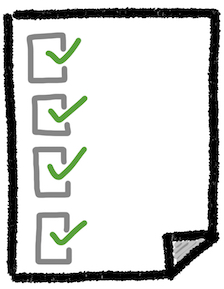Survey Best Practices
Conducting surveys can provide useful answers to specific questions. Surveys don't need to be complex or exhausting to provide valuable information and insights. If you've ever wondered how to conduct a good survey, these tips will help.
- Keep questions relevant and specific
- Make questions short
- Use simple language
- Ask about one thing at a time
- Avoid biased language & leading questions
- Put questions in a positive form
- Offer a balanced set of responses
- Adding a comments section for field notes

Keep questions relevant and specific
Ensure you're asking for pertinent information only. Avoid unnecessary details, feelings, and opinions unless they are important to your investigation. Staying focused on data critical to your objectives also keeps the process working smoothly without unnecessary delay. The "nice to have" information is great to collect if you can, but you don't want the collection of optional data to detract from your primary data points.
Make questions short
Keep your questions as direct and to-the-point as possible. The more specific the question, the less risk there is of a collector misreading the question and answering incorrectly. Breaking up a survey into many smaller questions versus a few long ones results in richer, more useful data in the end. An added benefit of short, direct questions is the data capture process can flow with fewer delays and require less thinking from element to element.
Use simple language
Be clear and obvious about what you're asking. Avoid flowery language, terminology, and euphemisms, and ask questions in an unbiased, objective fashion. Sometimes, technical jargon may be required, but keep in mind the audience that's being asked to complete the survey. Ask yourself: Is this term something my target audience will understand? The best data collection surveys can often be deployed and used with minimal training of collectors in the specifics.
Ask about one thing at a time
One question, one answer. Ask for one thing at a time, and avoid open-ended questions without a clear answer. Breaking up a survey into more small questions rather than few large ones provides the added benefit of being able to slice up the data in myriad different ways once you've finished your project. Analysts can get more granular in querying the data for answers.
Avoid biased language & leading questions
Phrase your questions to be considerate, inclusive, and respectful. Don't frame up or lead the question with unnecessary adjectives and adverbs that may bias a respondee's answer. Remain objective and avoid asking questions that may direct or lead the subject to answer in a particular way.
Put questions in a positive form
Phrasing questions negatively can be confusing and may bias your responses. It can be confusing to ask about what is not, instead ask about what is. If you can reduce questions down to a binary "yes or no" question, that makes things even simpler for the collector to understand.
Consider the ordering of questions
The order in which you display the questions on your survey form can make the difference between correct and inaccurate data. This is where field testing helps you iterate your design process to get the structure just right. For ease-of-use, most of the time your questions should flow in the order the collector typically conducts the survey. If they're doing a construction site walkthrough inspection, structure the survey in the order the inspector moves through the site.
Offer a balanced set of responses
Give a range of answers that are inclusive and thorough. Avoid errors of omission by including multiple options that cover all possible responses to the question. Using an "Other" option within choice lists helps avoid getting overly specific with options that are predetermined.
Add a comments section for field notes
Sometimes in the field, you might find important notes, data, or additional information you may want to relay to the analysts. An optional comments section at the bottom of your survey allows users to add important information that otherwise might have been overlooked. It functions as a good catch-all for anything your survey model might not have accommodated for.
1. Surveying birds https://www.flickr.com/photos/alaskanps/16290334145/ ↩
